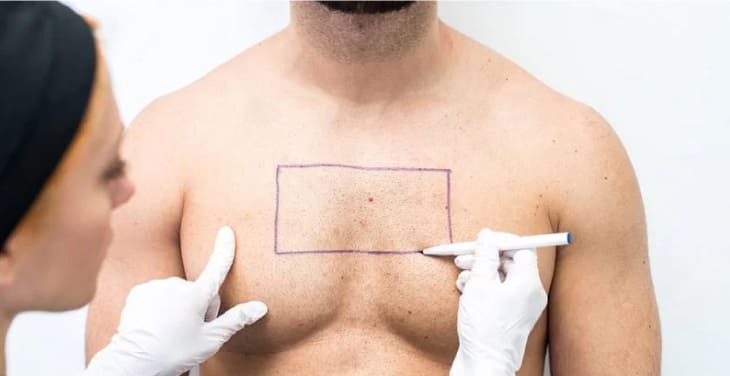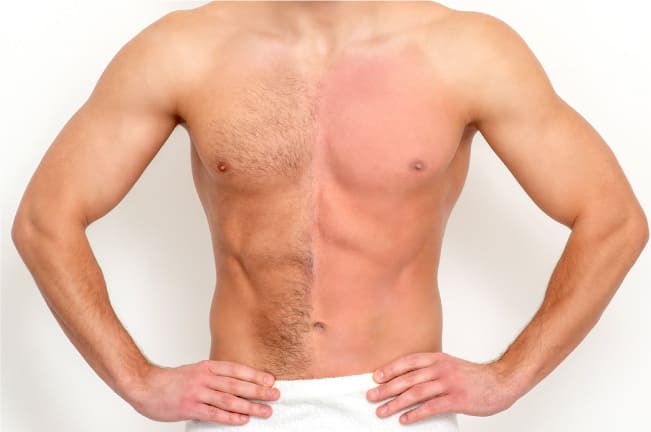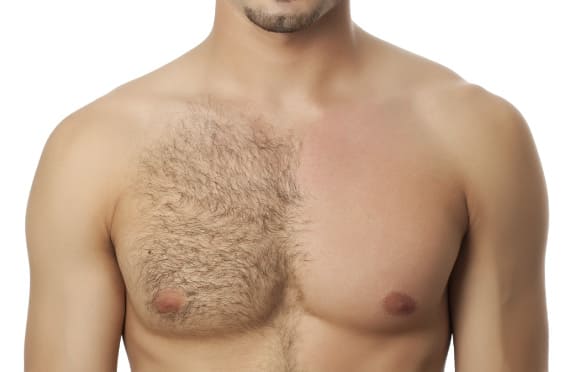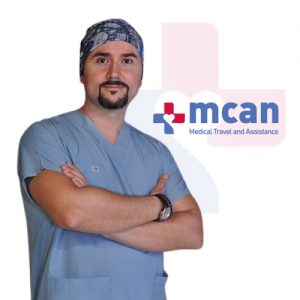There is no need to worry if you have a poor-quality donor area at the back of your scalp. Body hair transplant becomes an alternative for you to have your hair transplantation seamlessly. How about filling out the application form for free online consultation and treatment plan?
What is Body Hair Transplantation?
Body hair transplant is a hair saver for those whose donor area is not available for hair transplantation. A hair transplant procedure is performed by extracting hair follicles from the back of the head (nape area as a donor zone) to be transplanted into the recipient area. In hair transplantation, the donor area’s health, sufficiency, and density are essential for the procedure’s outcome. Despite having limited and unhealthy donor areas, individuals can still undergo the operation with the help of body hair transplantation.

When the traditional donor area on the back of the head (the nape) is not sufficient or suitable for transplantation for various reasons like a lack of hair density or scarring, surgeons may consider alternative donor areas. These alternative donor areas include beard, chest, back, and leg hair.
The surgeon will evaluate the hair qualities from these other places to determine their eligibility for transplantation if the nape area cannot provide enough hair grafts. Beard hair, if the individual has sufficient hair in his beards, is a popular choice as an alternative donor area. Because its hair characteristics similarity to scalp hair in terms of thickness and texture, extracting hair from beard hair is the best way to maintain the procedure. However, if the beard is not appropriate for extraction, the other alternatives also help.
Beard Hair:
The hair follicles in the beard region typically have a similar caliber to scalp hair, making them compatible for transplantation. Moreover, beard hair tends to grow longer than other body hair, which can be advantageous for achieving natural-looking results in some regions of the scalp.
Chest Hair:
Chest hair is another potential donor source, although it may have a slightly different texture and growth pattern than scalp hair. Chest hair is usually coarser and shorter, which might be less ideal for certain hair restoration cases, especially for recreating a hairline or frontal region; however, in cases where the patient has good-quality chest hair and requires additional grafts, surgeons can consider it an option.
Back Hair:
Back hair can be a donor source, especially if the patient has enough hair growth. Back hair is typically coarser and shorter than chest hair, making it better suited for adding coverage than resembling hairlines or frontal areas.
Leg Hair:
In some instances, when the patient has limited hair elsewhere, leg hair might be considered as a donor source. However, due to its finer and shorter nature than scalp hair, there are better choices for transplantation. It’s typically used as a last resort when other donor areas are unsuitable. Using leg hair can be more challenging due to texture and growth differences, leading to varying results compared to scalp or other body hair.
Benefits and Considerations of Body Hair Transplant to the Head
Body hair transplant, as with any other procedure, comes with some advantages and disadvantages.
Advantages:
- Body hair transplantation becomes a feasible choice for individuals who have utilized all their available scalp donor hair or are unsuitable candidates for conventional hair restoration methods.
- It allows individual with limited scalp hair to undergo hair restoration. It is a great opportunity for people with advanced hair loss.
- Hair obtained from body areas like the beard and chest can offer denser coverage to areas needing extra grafts, resulting in an improved overall density and a more natural look for the transplantation.
Disadvantages:
- Body hair transplant can cause variability in results. The growth rate, texture, and overall appearance of transplanted body hair may not always match the native scalp hair.
- The complexity and requirement for specialized techniques make body hair transplant typically more costly than traditional hair restoration procedures.
- Compared to regular scalp hair transplantation, body hair transplant can take longer and may require multiple sessions to attain the desired outcomes.
The Process of Body Hair Transplant to Head
Before proceeding with a body hair transplant, the initial step involves a crucial consultation to determine the patient’s eligibility for the procedure. During this consultation, the surgeon evaluates the patient’s hair loss condition and carefully selects the appropriate donor area from which hair follicles will be extracted.
Evaluation and Patient Selection Criteria
The evaluation part of the procedure is significant to provide optimal results. Therefore, during the evaluation, the surgeon will analyze the patient’s extent of hair loss, hair texture and color, donor area quality and quantity, and medical history.
Are you eligible for a body hair transplant?
- The success of the procedure relies heavily on the strength, health, and characteristics of the hair in the potential donor regions, such as the beard, chest, back, arms, and legs. The donor hair must exhibit similarities to scalp hair to achieve optimal outcomes.
- BHT is commonly recommended for individuals who experience extensive hair loss or lack sufficient donor hair on the scalp for conventional methods like FUE. Suitable candidates should exhibit noticeable bald patches or thinning hair on the scalp.
- The candidate’s hair texture and body hair color should match the recipient area on the scalp to ensure a natural-looking result.
- A thorough medical evaluation is essential to ensure the patient is in good overall health and can safely undergo the surgical procedure. Therefore, necessary blood tests are maintained, and the patient’s medical history is evaluated.

Extraction Techniques for Body Hair
FUE hair transplant, Follicular Unit Extraction technique can be used when performing a body hair transplant.
FUE Hair Transplant:
One of the most popular methods in hair transplantation, FUE hair transplant is a minimally invasive procedure proven its success significantly in terms of results.The benefit of FUE is its ability to avoid creating a linear scar, with the resulting scars being very small and hardly noticeable. This characteristic has made it a widely preferred option for extracting body hair.
DHI Hair Transplant:
DHI (Direct Hair Implantation) can also be applied for body hair transplantation. Although DHI is typically linked with scalp hair transplantation, the method can be adjusted to transfer hair from body donor regions to the scalp. The fundamental concept of DHI remains unchanged, regardless of whether the donor’s hair is sourced from the scalp or other body areas like the beard, chest, back, arms, or legs. The specialized Choi Implanter Pen facilitates accurate and controlled hair follicle implantation, making it a versatile option for various donor regions.
Implantation Process
The implantation process proceeds according to the chosen technique.As with any other procedure, local anesthesia is applied to numb the donor and recipient areas. If the technique is FUE, the surgeon makes the incisions for the recipient area to prepare the site for implantation after extracting hairs from the donor zone. If the method is DHI, canal opening is done simultaneously with implantation.
Both techniques aim to achieve successful hair transplantation by carefully placing the hair follicles into the recipient area, ensuring they grow naturally and blend seamlessly with the existing hair. The choice between FUE and DHI depends on various factors, including the patient’s specific needs, the surgeon’s expertise, and the characteristics of the donor and recipient areas.

Fast Facts Body Hair Transplant to Head
| Operation Goal: | To regain lost hair for those whose nape area is insufficient for the transplantation. |
|---|---|
| Duration of the Operation: | Around 4-8 hours. |
| Anesthesia: | Local Anesthesia. |
| Staying in the hotel: | 2-3 Days |
| In/Outpatient: | Outpatient |
| Possible Side Effects: | Pain, discomfort, swelling, bleeding, infection, numbness, scarring, shock loss. |
The Cost of Body Hair Transplant
The Cost of a Hair Transplant in Turkey at MCAN Health is not based on the number of grafts but on the number of sessions.
If it is necessary to combine body hair transplantation and regular scalp transplantation, the cost will include both the regular one and the body-hair transplant.
If there is a need for a second session, then the cost will be considered as a different session price.
MCAN Health performs body hair transplantation in Istanbul, Turkey, with the most experienced surgeons. Our prices halve those of any European country due to Turkish Government incentives for medical tourism and relatively cheap labor cost.
Body Hair to Head Transplant Aftercare
When the procedure is completed successfully, the aftercare phase of the transplantation starts immediately. In this process, patients should be aware of do’s and dont’s to get over successfully and have the desired results.
- Don’t Touch or Pick at the Transplanted Area: Avoid touching, scratching, or picking at the transplanted area, as this can damage the newly implanted hair follicles and delay healing.
- Don’t Shave the Donor Area: Avoid shaving the donor area until your surgeon gives you the green light. Shaving too soon after the procedure may disrupt the healing process.
Frequently Asked Questions

Didn’t find your question?
You can ask any questions you have regarding Body Hair to Head Transplant in Turkey right now!
The body hair transplant procedure usually lasts for several hours, and the exact duration can differ depending on the size of the transplant and the number of grafts involved. On average, the procedure takes around 4 to 8 hours, but it might take even longer in certain situations.
Body hair transplant, as with other methods, is a permanent solution for hair restoration. Since hair follicles are extracted from body areas unaffected by male pattern baldness or hair loss issues, it is unlikely to experience hair loss in recipient areas.
A body hair transplant can look natural with the expertise of skilled surgeons and attention to detail. The procedure’s success depends on texture and color matching, proper hair placement, patient-specific characteristics, healing, and growth. While it can provide significant improvement, it may achieve a different density than scalp hair transplants.
Body hair can be incorporated alongside scalp donor hair during transplant surgeries. Surgeons commonly employ body hair as an extra donor source when there is inadequate scalp hair or if the patient seeks improved hair density. This combination provides enhanced flexibility and better coverage for hair restoration. The decision to use body hair in conjunction with scalp hair depends on the individual patient’s circumstances, the quality of the body hair, and the surgeon’s proficiency in conducting such combined transplants.
There are limitations to the number of body hair grafts that can be used in a hair transplant. The availability of suitable body hair varies among individuals, and the quantity that can be harvested may need to be increased for extensive coverage. Additionally, body hair’s texture and growth characteristics may differ from scalp hair, which can impact the final results. While body hair can be a valuable additional donor source, practical limitations in quantity, quality, and compatibility need to be considered during the transplant planning process.
Dr. Sefadiye, who holds a Medical Degree (M.D) in the Faculty of Medicine from Ege University, has specialized in medical aesthetics. Dr. Sefadiye's admiration for Medical Aesthetics was shaped while studying and led her to have various educational pieces of training. Mainly focused on hair transplantation, Dr. Safediye performs, ozone therapy, mesotherapy, acupuncture, and aesthetic fillings.
Published by MCAN HEALTH
Published:
Updated:
- National Library of Medicine, “Is Every Patient of Hair Loss a Candidate for Hair Transplant?—Deciding Surgical Candidacy in Pattern Hair Loss”, December 20, 2021, https://www.ncbi.nlm.nih.gov/pmc/articles/PMC8719975/ (Date of Access: 29.05.2023)





